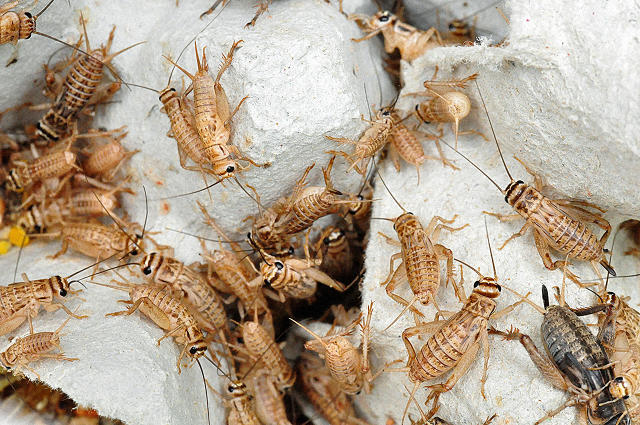This Startup Is constructing A model For the first excessive-Tech Cricket Farm
Tiny Farms is getting ready for a world where we exchange—or at the least complement—meat consumption with insects. First step: grow a number of bugs.
March 3, 2015
like the prototypical Silicon Valley startup, Oakland-based Tiny Farms is launching in a storage, the brainchild of tech world founders. but instead of engaged on the subsequent app, the corporate is making an attempt to construct a adaptation for a better cricket farm—the kind of industrial-scale facility that would in the end make eating bugs as accessible as hen.
“We have been having a look at food manufacturing, and ways lets practice what we know about—design, sensing, and information capture—to something that may mainly increase the efficiency of our food gadget,” says Tiny Farms co-founder Daniel Imrie-Situnayake. Their analysis pointed to bugs as an answer for growing sustainability and manufacturing challenges.
Then the UN revealed a document announcing that we will have to all be consuming extra insects, and malicious program-filled meals startups started to pop up. the one problem: no one actually knew easy methods to effectively produce something like crickets on a major scale. that’s the problem that Tiny Farms hopes to unravel.

“should you consider where farming was once a number of hundred years in the past, when the majority of manufacturing used to be through subsistence farming, individuals had very idiosyncratic tactics,” says Imrie-Situnayake. “They didn’t have great gear, they did not have get right of entry to to science and engineering that could lend a hand them do things more productively. that’s principally the place insect farming is today.”
right now, raising a crop of bugs takes quite a few human labor; farmers must feed crickets by means of hand, for example, as an alternative of with the ability to use an automated device.
“We’re using knowledge to optimize your complete course of—from breeding bugs to feeding them, rearing them, all of the way to processing and distributing them,” explains Imrie-Situnayake. “Our models inform us where the bottlenecks are. Then we’re in a position to use modern tactics like speedy prototyping to construct and take a look at solutions.”
by means of reducing human labor, the startup thinks it’ll be that you can think of to provide insects at a scale that may begin to interchange some meat.
“Designing systems that are straightforward and provide minimal human intervention to run can can help you handle in point of fact kind of outstanding amounts of food,” says Imrie-Situnayake. “if you happen to take into consideration what number of crickets you wish to feed a city or a state, if people are eating these ceaselessly, you are going to want a whole bunch of tons monthly. And using the current ways which is simply now not that you can think of.”
After serving as consultants to other bug farms, like giant Cricket Farms in Ohio, Tiny Farms is now elevating a spherical of investment to construct out their research and building facility and start creating their information-driven tech for the cricket farm of the future. the corporate hopes to use the same course of to build models for other sorts of bugs as well.
“We’re trying to determine it out first with crickets—how do you identify bottlenecks and build the hardware and the community on the way to permit you to produce effectively,” he says. “Then how do you generalize that. There are nearly one million species of insects, and lots of them are recognized to be fit to be eaten. bugs are an enormous untapped biological resource.”
of their new facility, the company plans to supply cricket flour at an industrial scale, and promote it to different organiztions as they check the know-how. in a roundabout way, a few years from now, it hopes to show the operation right into a franchise edition.

“if you’re a farmer and you have got some buildings on hand, and you might be looking for an additional earnings flow, we are going to basically offer you the whole thing you wish to be producing crickets extremely efficiently,” says Imrie-Situnayake. “you’ll be able to feed that into our network where we do all of the high quality assurance, processing, and distribution.”
The startup is sure that the market for insect food will grow speedy. “i believe it already has been fairly quick,” Imrie-Situnayake says. “Two years ago we weren’t anticipating there to be this kind of demand as there may be nowadays. i think it roughly caught everyone abruptly.”
“it’s principally the subsequent superfood,” he adds. “it’s a healthy and sustainable approach to get some protein. The market size for equivalent categories, even niche products, will get into the masses of millions beautiful fast.”
If only one in a hundred american citizens eats one part of cricket flour a month—the equivalent amount of protein in half of a rooster breast—that equates to lots of of thousands and thousands of bucks a 12 months in insect production, he explains.
“that is before we even begin talking about mass market adoption,” he says. “And after that there is a tremendous opportunity to produce meals that a lot of people already eat around the world. they only don’t seem to be producing it effectively.”
[prime photo: USGS Flickr]
fast company , learn Full Story
(142)














